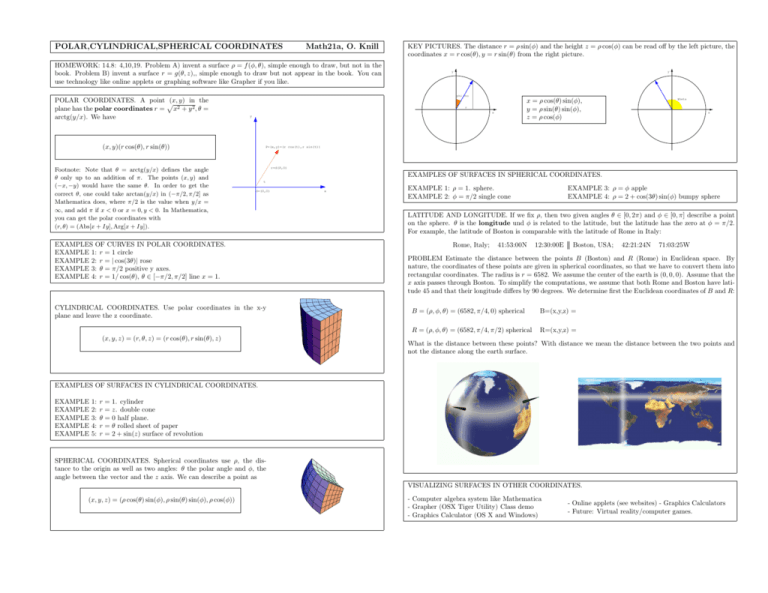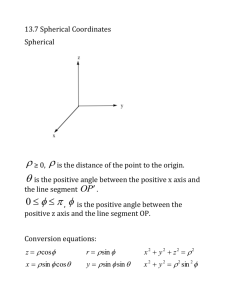POLAR,CYLINDRICAL,SPHERICAL COORDINATES Math21a, O
advertisement

POLAR,CYLINDRICAL,SPHERICAL COORDINATES Math21a, O. Knill HOMEWORK: 14.8: 4,10,19. Problem A) invent a surface ρ = f (φ, θ), simple enough to draw, but not in the book. Problem B) invent a surface r = g(θ, z),, simple enough to draw but not appear in the book. You can use technology like online applets or graphing software like Grapher if you like. POLAR COORDINATES. A point p (x, y) in the plane has the polar coordinates r = x2 + y 2 , θ = arctg(y/x). We have y y phi rho x = ρ cos(θ) sin(φ), y = ρ sin(θ) sin(φ), z = ρ cos(φ) r x y (x, y)(r cos(θ), r sin(θ)) Footnote: Note that θ = arctg(y/x) defines the angle θ only up to an addition of π. The points (x, y) and (−x, −y) would have the same θ. In order to get the correct θ, one could take arctan(y/x) in (−π/2, π/2] as Mathematica does, where π/2 is the value when y/x = ∞, and add π if x < 0 or x = 0, y < 0. In Mathematica, you can get the polar coordinates with (r, θ) = (Abs[x + Iy], Arg[x + Iy]). KEY PICTURES. The distance r = ρ sin(φ) and the height z = ρ cos(φ) can be read off by the left picture, the coordinates x = r cos(θ), y = r sin(θ) from the right picture. r theta x P=(x,y)=(r cos(t),r sin(t)) r=d(P,O) EXAMPLES OF SURFACES IN SPHERICAL COORDINATES. t O=(0,0) EXAMPLES OF CURVES IN POLAR COORDINATES. EXAMPLE 1: r = 1 circle EXAMPLE 2: r = | cos(3θ)| rose EXAMPLE 3: θ = π/2 positive y axes. EXAMPLE 4: r = 1/ cos(θ), θ ∈ [−π/2, π/2] line x = 1. CYLINDRICAL COORDINATES. Use polar coordinates in the x-y plane and leave the z coordinate. (x, y, z) = (r, θ, z) = (r cos(θ), r sin(θ), z) x EXAMPLE 1: ρ = 1. sphere. EXAMPLE 2: φ = π/2 single cone EXAMPLE 3: ρ = φ apple EXAMPLE 4: ρ = 2 + cos(3θ) sin(φ) bumpy sphere LATITUDE AND LONGITUDE. If we fix ρ, then two given angles θ ∈ [0, 2π) and φ ∈ [0, π] describe a point on the sphere. θ is the longitude und φ is related to the latitude, but the latitude has the zero at φ = π/2. For example, the latitude of Boston is comparable with the latitude of Rome in Italy: Rome, Italy; 41:53:00N 12:30:00E Boston, USA; 42:21:24N 71:03:25W PROBLEM Estimate the distance between the points B (Boston) and R (Rome) in Euclidean space. By nature, the coordinates of these points are given in spherical coordinates, so that we have to convert them into rectangular coordinates. The radius is r = 6582. We assume the center of the earth is (0, 0, 0). Assume that the x axis passes through Boston. To simplify the computations, we assume that both Rome and Boston have latitude 45 and that their longitude differs by 90 degrees. We determine first the Euclidean coordinates of B and R: B = (ρ, φ, θ) = (6582, π/4, 0) spherical B=(x,y,z) = R = (ρ, φ, θ) = (6582, π/4, π/2) spherical R=(x,y,z) = What is the distance between these points? With distance we mean the distance between the two points and not the distance along the earth surface. EXAMPLES OF SURFACES IN CYLINDRICAL COORDINATES. EXAMPLE EXAMPLE EXAMPLE EXAMPLE EXAMPLE 1: 2: 3: 4: 5: r = 1. cylinder r = z. double cone θ = 0 half plane. r = θ rolled sheet of paper r = 2 + sin(z) surface of revolution SPHERICAL COORDINATES. Spherical coordinates use ρ, the distance to the origin as well as two angles: θ the polar angle and φ, the angle between the vector and the z axis. We can describe a point as VISUALIZING SURFACES IN OTHER COORDINATES. (x, y, z) = (ρ cos(θ) sin(φ), ρ sin(θ) sin(φ), ρ cos(φ)) - Computer algebra system like Mathematica - Grapher (OSX Tiger Utility) Class demo - Graphics Calculator (OS X and Windows) - Online applets (see websites) - Graphics Calculators - Future: Virtual reality/computer games.







